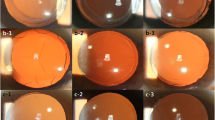Abstract
Purpose
To present a surgical intervention for a posterior haptic trapped between the cartridge and plunger during intraocular lens (IOL) implantation.
Materials and methods
Posterior haptic incarceration was detected in 36 cases during implantation of a one-piece foldable IOL during cataract surgery with phacoemulsification. In 11 of the patients (Group 1), recovery was achieved by forcibly pulling out the incarcerated posterior haptic. In 25 cases (Group 2), the haptic was recovered by using an MVR knife to cut the cartridge tip from the bottom up parallel to the trapped haptic.
Results
In Group 1, tears were seen on the incarcerated haptic in all cases (100%). In Group 2, the procedure was successful in all 25 cases and there was no accidental cutting of the haptic. In all cases, the surgeries were completed with the recovered IOL in Group 2.
Conclusions
Posterior haptic incarceration in cataract surgery can be solved by the simple and easy method of cutting the cartridge tip from the bottom upwards and releasing the haptic.

Similar content being viewed by others

References
Ouchi M (2012) Effect of intraocular lens insertion speed on surgical wound structure. J Cataract Refract Surg 38:1771–1776
Milazzo S, Turut P, Blin H (1996) Alterations to the AcrySof intraocular lens during folding. J Cataract Refract Surg 22:1351–1354
Vrabec MP, Syverud JC, Burgess CJ (1996) Forceps-induced scratching of a foldable acrylic intraocular lens [letter]. Arch Ophthalmol 114:777
Pfister DR (1995) Stress fractures after folding an acrylic intraocular lens. Am J Ophthalmol 121:572–574
Carlson KH, Johnson DW (1995) Cracking of acrylic intraocular lenses during capsular bag insertion. Ophthalmic Surg Lasers 26:572–573
Kleinmann G, Apple DJ (2007) Evaluation of a new soft tipped injector for the implantation of foldable intraocular lenses. Br J Ophthalmol 9:1070–1072
Koch PS, Katzen LE (1994) Stop and chop phacoemulsification. J Cataract Refract Surg 20:566–570
Chai F, Ma B, Yang XG, Li J, Chu MF (2017) A pilot study of intraocular lens explantation in 69 eyes in Chinese patients. Int J Ophthalmol 10:579
Oltulu R, Erşan İ, Şatırtav G, Donbaloglu M, Kerimoğlu H, Özkağnıcı A (2015) Intraocular lens explantation or exchange: indications, postoperative interventions, and outcomes. Arq Bras Oftalmol 78:154–157
Fernández-Buenaga R, Alio JL, Pérez-Ardoy AL, Larrosa-Quesada A, Pinilla-Cortés L, Barraquer R, Alio JL 2nd, Muñoz-Negrete FJ (2013) Late in-the-bag intraocular lens dislocation requiring explantation: risk factors and outcomes. Eye 27:795–802
Biswas P, Sengupta S, Paul A, Kochgaway L, Biswas S (2012) Descemet’s tear due to injector cartridge tip deformity. Indian J Ophthalmol 60:218–220
Kohnen T, Magdowski G, Koch DD (1996) Scanning electron microscopic analysis of foldable acrylic and hydrogel intraocular lenses. J Cataract Refract Surg 22:1342–1350
Funding
This research did not receive any specific grant from funding agencies in the public, commercial or not-for-profit sectors.
Author information
Authors and Affiliations
Corresponding author
Ethics declarations
Conflict of interest
Yusuf Koçluk, Emine Alyamaç Sukgen, Burcu Kasım and Oğuzhan Saygılı declare that they have no conflict of interest.
Ethical approval
All procedures performed in studies involving human participants were in accordance with the ethical standards of the institutional and/or national research committee and with the 1964 Declaration of Helsinki and its later amendments or comparable ethical standards.
Informed consent
Informed consent was obtained from all individual participants included in the study.
Electronic supplementary material
Below is the link to the electronic supplementary material.
Recovery of the incarcerated haptic (MP4 57538 kb)
Rights and permissions
About this article
Cite this article
Koçluk, Y., Alyamaç Sukgen, E., Kasım, B. et al. A practical and easy surgical technique for recovery of an incarcerated haptic. Int Ophthalmol 39, 2077–2081 (2019). https://doi.org/10.1007/s10792-018-1047-3
Received:
Accepted:
Published:
Issue Date:
DOI: https://doi.org/10.1007/s10792-018-1047-3



